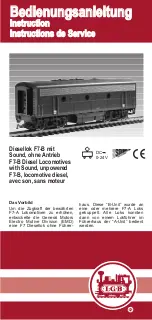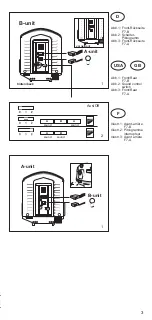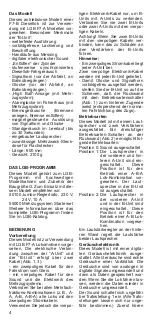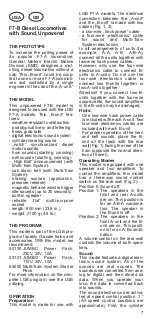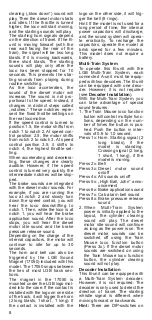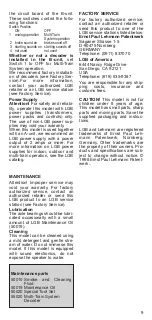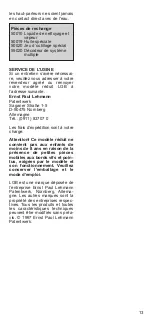
clearing („blow down“) sound will
play. Then the diesel motor starts
and idles. If the throttle is turned
higher, the loco will start moving,
and the starting sounds will play.
The starting horn signals depend
on the direction of travel. If the B-
unit is moving forward (with the
rear wall facing the rear of the
train), the signal will be two long
blasts. If it is moving backwards,
three short blasts. The starting
sounds will play only after the
loco has been stopped for 10
seconds. This prevents the star-
ting sounds from playing during
routine switching.
As the loco accelerates, the
sound of the diesel motor will
increase. The sound is not pro-
portional to the speed. Instead, it
changes in distinct steps called
„notches.“ These notches repre-
sent the fixed throttle settings on
the real locomotive.
If the speed control is turned to
position 1.5, the motor shifts from
notch 1 to notch 2. At speed con-
trol position 2.5, the motor shifts
from notch 2 to notch 3. At speed
control position 3.5, it shifts to
notch 4, the highest throttle set-
ting.
When accelerating and decelera-
ting, these changes are clearly
audible. However, if the speed
control is turned very quickly, the
intermediate notches will be skip-
ped.
The brake sounds are integrated
with the diesel motor sounds. For
example, if you are running the
loco at notch 2 and slowly turn
down the speed control, you will
hear the loco downshifting to
notch 1. Then, while the loco is at
notch 1, you will hear the brake
application sound. After the loco
stops, you will hear the diesel
motor idle sound and the brake
pressure release sound.
Depending on the charge of the
internal capacitors, the motor will
continue to idle for up to 30
seconds.
The horn and bell can also be
triggered by the LGB Sound
Magnet (17050) included with this
model. The 17050 snaps between
the ties of most LGB track sec-
tions.
The magnet in the 17050 is
mounted under the LGB logo mol-
ded into the case. If the contact is
installed with the logo on one side
of the track, it will trigger the horn
(2 long blasts, 1 short , 1 long). If
the contact is installed with the
logo on the other side, it will trig-
ger the bell (8 rings).
Hint: If the model is not used for a
long period of time, the internal
power capacitors will discharge,
and the sound system will opera-
te erratically. To recharge the
capacitors, operate the model at
brisk speed for a few minutes.
This model does not require a
battery.
Multi-Train System
To operate this B-unit with the
LGB Multi-Train System, each
connected A-unit must be equip-
ped with two decoders. The B-unit
can be equipped with one deco-
der. However, it is not required
(see Decoder Installation).
With the Multi-Train System, you
can take advantage of special
sound features:
1. The Train Mouse loco function
button will control multiple func-
tions, depending on the num-
ber of times the button is pus-
hed. Push the button in inter-
vals of 0.6 to 1.0 second.
Press 1x: Horn. Starting signal (2
long blasts), if the
model is standing.
Crossing signal (2 long,
1 short, 1 long), if the
model is moving.
Press 2x: Bell
Press 3x: Diesel motor sound
on/off
Press 4x: All sounds on/off
Press 5x: „High Ball, John“ anno-
uncement
Press 6x: Brake application sound
Press 7x: Cab alarm bell sound
Press 8x: Brake pressure release
sound
2. When Multi-Train System
power is initially applied to the
layout, the cylinder clearing
sound will play. The diesel
motor idle sound will continue
as long as the power is on. The
diesel motor sounds can be
switched off using the Train
Mouse loco function button
(Press 3x). If the diesel motor
sounds are switched on using
the Train Mouse loco function
button, the cylinder clearing
sound will not play.
Decoder Installation
This B-unit can be equipped with
a Multi-Train System decoder.
However, it is not required. The
decoder is only used to detect the
direction of travel. The starting
whistle signal is different when
moving forward or backwards.
Hint: There are DIP-switches on
8

